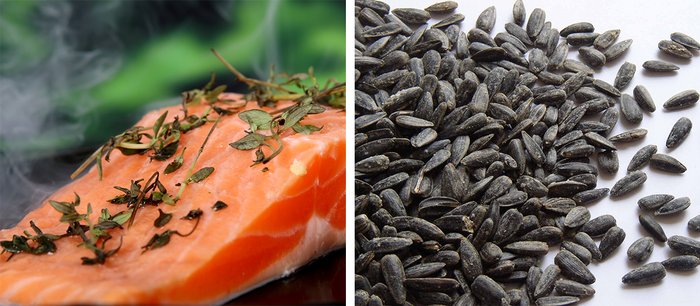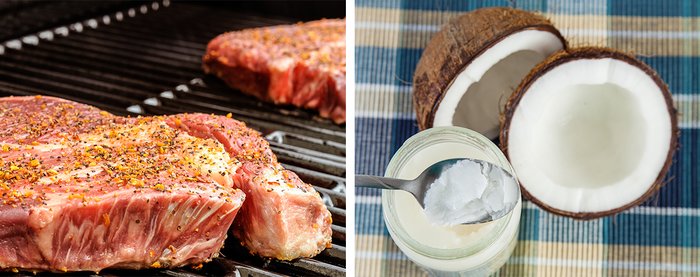Years of fat phobia have left a bad taste in our mouths. Actually, it's not just bad–it's dry and flavorless, and for the most part, unwarranted. Most dietary fats have beneficial effects on cellular, cardiovascular, cognitive, and metabolic health, and work to improve body composition.
While most fats are good for you, some are not. Here's what you need to know about the possible impact fats have on your health, performance, and body composition.
Why do I Need Fat?
Protein and carbohydrates certainly steal the macronutrient spotlight, but fats play a vital role that shouldn't go unnoticed. Sure, carbohydrates may be the first nutrient to come to mind when you think energy, but fat is an energy source, too. In fact, gram for gram, fat contains more calories (energy) than the other macronutrients combined; protein and carbohydrates both provide 4 calories per gram, while fat contains 9 calories! Couple this with the fact that all the cells in your body, as well as most physiological processes, require fat, and it's baffling to see people still avoid fat like the plague.
Furthermore, fat is also a major storage vesicle for the fat-soluble vitamins–A, D, E, and K. Oh, and did I mention it plays a crucial role in testosterone and vitamin-D production?
Unsaturated Fats

These fats may help support heart health because of their ability to support healthy cholesterol levels.[1] It's no wonder life expectancy is higher in European countries, many of which favor the Mediterranean diet, of which unsaturated fats are a staple![2,3]
Unsaturated fats are quite stable at high temperatures, making them a great choice for cooking.
Essential Fatty Acids
Although both omega-3 and omega-6 fatty acids are essential, focus on omega-3 fatty acids; the typical American diet already contains plenty of omega-6 fatty acids. Too high of a ratio between 6 and 3 may negatively affect your health, because omega-6 fatty acids possess strong pro-inflammatory properties.[4]
Touted as the "heart-healthy" fats, omega-3 fatty acids also exhibit powerful metabolic, and cognitive benefits. Avid exercisers will be happy to know that such fats also support a healthy inflammatory response after workouts, which may help promote recovery.[5-9]
Omega-3s may also positively influence how your body handles glucose. Research out of Scientific Reports found that consuming a smaller omega-6 to omega-3 ratio (which occurs when you consciously strive to increase your omega-3 intake) was associated with supporting insulin sensitivity.[10] Insulin sensitivity is a sign of glucose utilization and storage. When your insulin sensitivity is optimal, glucose is less likely to be directed toward fat cells.
Saturated Fat

Conventional wisdom long held that saturated fat was a health risk, because it raised blood levels of both LDL and HDL cholesterol.[11,12] However, recent research has demonstrated that when HDL ("good" cholesterol) rises alongside LDL ("bad" cholesterol), the cardiovascular risks of higher cholesterol levels may not be as drastic as previously assumed.[13] Thank goodness for second chances!
Additionally, some saturated fats, such as coconut oil, are rich in medium-chain triglycerides (MCTs). MCTs are unique in that they bypass the liver and immediately enter the blood stream. This makes them readily available to be used as fuel and potentially less likely to be stored as fat. Diets higher in MCTs may also help promote satiety and ultimately assist in weight loss.[15]
Saturated fat also plays a crucial role in testosterone production. Consequences of low testosterone include decreased muscle building, and diminished performance.[16-18] Fortunately, a bit of a bump in your fat macros can help support healthy testosterone levels. A study out of the Journal of Applied Physiology found that diets higher in mono-unsaturated and saturated fat were related to higher testosterone levels.[19]
Trans Fats

Trans fats–commonly found in doughnuts, cookies, cakes, and other baked goods–raise "bad" cholesterol while simultaneously reducing "good" cholesterol.[20] This is a recipe for disaster and a slew of metabolic complications. Even more, animal models have shown that increasing the amount of trans fat you consume may wreak havoc on proper glucose disposal, raising the likelihood of insulin resistance and abdominal obesity.[21] So next time, think twice before choosing that second doughnut or third cookie.
References
- Fernandez, M. L., & West, K. L. (2005). Mechanisms by which Dietary Fatty Acids Modulate Plasma Lipids. The Journal of Nutrition, 135 (9), 2075-2078.
- Crous-Bou, M., Fung, T. T., Prescott, J., Julin, B., Du, M., Sun, Q., ... & De Vivo, I. (2014). Mediterranean diet and telomere length in Nurses' Health Study: population based cohort study. British Medical Journal, 349, g6674.
- Nilsson, P. M. (2014). Mediterranean diet and telomere length. British Medical Journal, 349, g6843.
- Simopoulos, A. P. (2002). The importance of the ratio of omega-6/omega-3 essential fatty acids. Biomedicine and Pharmacotherapy, 56 (8), 365-379.
- Riccardi, G., Giacco, R., & Rivellese, A. A. (2004). Dietary fat, insulin sensitivity and the metabolic syndrome. Clinical Nutrition, 23 (4), 447-456.
- Vaughan, R. A., Garcia-Smith, R., Bisoffi, M., Conn, C. A., & Trujillo, K. A. (2012). Conjugated linoleic acid or omega 3 fatty acids increase mitochondrial biosynthesis and metabolism in skeletal muscle cells. Lipids in Health and Disease, 11 (142), 2090-2098.
- Maroon, J. C., & Bost, J. W. (2006). Omega-3 Fatty acids (fish oil) as an anti-inflammatory: an alternative to nonsteroidal anti-inflammatory drugs for discogenic pain. Surgical Neurology, 65 (4), 326-331.
- Xu, Y., & Qian, S. Y. (2014). Anti-cancer activities of omega-6 polyunsaturated fatty acids. Biomedical Journal, 37 (3), 112.
- Grosso, G., Pajak, A., Marventano, S., Castellano, S., Galvano, F., Bucolo, C., ... & Caraci, F. (2014). Role of omega-3 fatty acids in the treatment of depressive disorders: a comprehensive meta-analysis of randomized clinical trials. PloS One, 9 (5), e96905.
- Albert, B. B., Derraik, J. G., Brennan, C. M., Biggs, J. B., Smith, G. C., Garg, M. L., ... & Cutfield, W. S. (2014). Higher omega-3 index is associated with increased insulin sensitivity and more favourable metabolic profile in middle-aged overweight men. Scientific Reports, 4, 6697.
- Griel, A.E. & Kris-Etherton, P.M. (2006). Beyond saturated fat: The importance of the dietary fatty acid profile on cardiovascular disease. Nutrition Reviews, 64 (5), 257-262.
- Kris-Etherton, P.M. & Innis, S. (2007). Dietary Fatty Acids–Position of the American Dietetic Association and Dietitians of Canada. American Dietetic Association Position Report. Journal of the American Dietetic Association, 107 (9), 1599-1611.
- Hao, W., & Friedman, A. (2014). The LDL-HDL profile determines the risk of atherosclerosis: a mathematical model. PloS One, 9 (3), e90497.
- Marsh, J. B., & James, A. T. (1962). The conversion of stearic to oleic acid by liver and yeast preparations. Biochimica et Biophysica Acta, 60 (2), 320-328.
- St-Onge, M. P., & Jones, P. J. (2002). [Physiological effects of medium-chain triglycerides: potential agents in the prevention of obesity](http://Physiological effects of medium-chain triglycerides: potential agents in the prevention of obesity). The Journal of Nutrition, 132 (3), 329-332.
- Murphy, S., Khaw, K. T., Cassidy, A., & Compston, J. E. (1993). Sex hormones and bone mineral density in elderly men. Bone and Mineral, 20 (2), 133-140.
- Mauras, N., Hayes, V., Welch, S., Rini, A., Helgeson, K., Dokler, M., ... & Urban, R. J. (1998). Testosterone Deficiency in Young Men: Marked Alterations in Whole Body Protein Kinetics, Strength, and Adiposity 1. The Journal of Clinical Endocrinology & Metabolism, 83 (6), 1886-1892.
- Hansen, L., Bangsbo, J., Twisk, J., & Klausen, K. (1999). Development of muscle strength in relation to training level and testosterone in young male soccer players. Journal of Applied Physiology, 87 (3), 1141-1147.
- Volek, J. S., Kraemer, W. J., Bush, J. A., Incledon, T., & Boetes, M. (1997). Testosterone and cortisol in relationship to dietary nutrients and resistance exercise. Journal of Applied Physiology, 82 (1), 49-54.
- Brouwer, I. A., Wanders, A. J., & Katan, M. B. (2010). Effect of animal and industrial trans fatty acids on HDL and LDL cholesterol levels in humans–a quantitative review. PloS One, 5 (3), e9434.
- Kavanagh, K., Jones, K. L., Sawyer, J., Kelley, K., Carr, J. J., Wagner, J. D., & Rudel, L. L. (2007). Trans fat diet induces abdominal obesity and changes in insulin sensitivity in monkeys. Obesity, 15 (7), 1675-1684.

